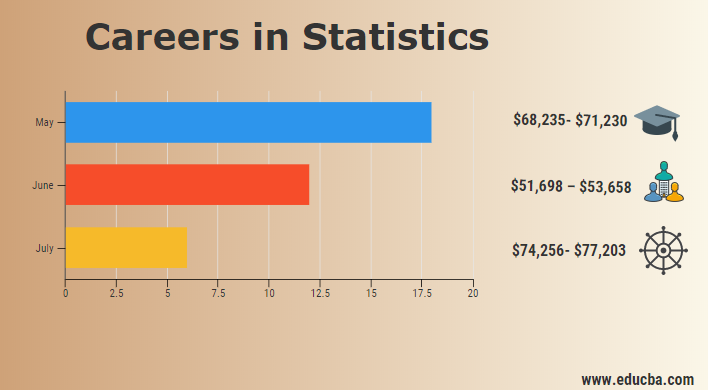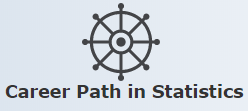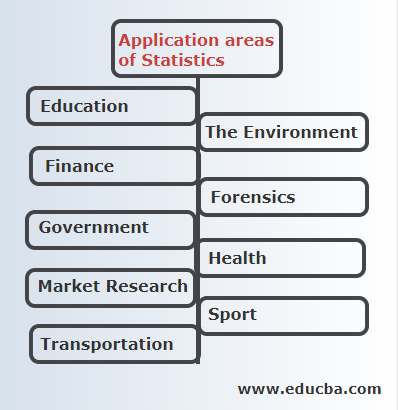Updated June 29, 2023
Introduction to Careers in Statistics
In this topic, we will learn about Careers in Statistics as we heard about big data technologies and how data from different sources are brought together to form big data warehouses. But what to do with them? Is only collecting data enough? Who will give insights into what is happening with the data? “Statisticians” are the ones who can look through the data and derive insights by converting it to information.
Some of the best ways to know how statisticians work can be seen in movies like Alan Turing’s “Imitation Game” and “Money Ball”.
Statisticians are the decision-makers in the real world when it comes to calling shots, like whether to invest in ABC company or not. Who would win the elections? What would be the oil price? What would be the airfare price? Etc
Education Required to Build Careers in Statistics
- A statistician should have a bachelor’s or master’s degree to build careers in statistics, mathematics, engineering, economics, or computer science.
- A statistician should have strong hands in SQL (Structured Query Language) to get the required data for analysis (Usually, the analysis (EDA Explanatory Data Analysis) is done on a small set of data).
- A modern-day statistician should also have strong coding skills, which can be used to design new algorithms. Python or R (These are the open software available) are the preferred languages (R is used for statistics); however, SAS is a licensed version.
- A statistician should have good written, oral communication skills and problem-solving skills.
- A statistician should be able to communicate results and findings to other non-statisticians and influence others.
- A statistician should have a practical and strategic approach to work and a high level of accuracy in detail.
- A statistician should be able to meet deadlines and work with teams or alone.
Responsibilities of Careers in Statistics
- A statistician should be able to consult with clients to discuss what data to be collected and how much data is needed to be collected.
- A statistician should be able to design experiments conduct trials on data, or generate questions for surveys to produce the required data.
- A statistician should interpret the data and make sure that the decisions he/she makes are not solely based on intuitions.
- A statistician should be able to present his/her results to senior managers, regulatory authorities, and clients, making key decisions based on results and advising policymakers and government authorities.
- A statistician should be able to conduct research, often as part of a team, and write reports or articles for publication.
Career Path in Statistics
There are two ways, one is the traditional way, and the other is the recent trendy way.
- A bachelor’s degree in Mathematics would be ideal for starting off in the traditional way.
- Then after the bachelor’s degree, a master’s degree program in the same field or a related field in statistics.
- It will be good to go for a Ph.D. program if one goes through the traditional way of making your career path in statistics.
- Internships and other career opportunities open once you do your master’s, and doing 2-3 internships would notch up your chance of getting your dream job.
- After that, one is good to go and have a full fledge full-time employment.
The trendy way is to pick up a micro-course in data science and participate in hackathons, opening up opportunities for people with a non – mathematics background.
Application Areas of Statistics
Careers in Statistics are used in every field nowadays, and here are a few of them.
Let’s look at a few of them in detail:
- In the education sector, for providing projections of future student numbers which will allow changes in the birth rate and assess the number of teachers that will be needed in the sector.
- In medicine, designing experiments to assess the effects of drugs and associated side effects or to design, implement, and analyze clinical studies.
- In the environment, collect data to monitor air pollution levels and toxic gas levels.
- In food, researchers collect data to measure the toxicity of food additives and recommend which items should be included in food production.
E.g., folic acid in bread making;
- In the field of market research for predicting demand for products and services, designing an experiment to improve the quality of products.
- In politics, statistics can be really useful for deriving the sentiment of the people and predicting the results.
- In transportation and logistics, companies can use statistics to predict the supply and demand of particular regions for piling up or reducing stocks.
Salary (US Data and Not India-Specific Figures)
The below table represents the salaries of the different job titles under which the statisticians are engaged in companies and their pay grade
| Job Title | Salary |
| Statistician I | $51,698 – $53,658 |
| Statistician II | $68,235- $71,230 |
| Statistician III | $74,256- $77,203 |
| Statistician IV | $92,585-$94,115 |
| Statistician V | $114,897-$116,544 |
| Economist(Corporate II) | $108,924-$110,789 |
| Economist(Corporate III) | $125,394 -$127,187 |
Conclusion or Career Outlook
Everyone looks out for a high-paying job, and what makes statistics stand out is that it can join the dots of a problem and give a solution that is notable based on intuition but backed up by real logical reasons from the data.
Statistics can also be applied to one’s personal life; for example, one may be interested in investments, say mutual funds, apply his stats skills and make some good money.
With the advent of technology like AI (Artificial Intelligence) and machine learning techniques, statistics have become a core course (backbone) of these technologies. Nowadays or shortly, one may call a statistician the “God of Data”.
Recommended Articles
We hope that this EDUCBA information on “Careers in Statistics” was beneficial to you. You can view EDUCBA’s recommended articles for more information.







